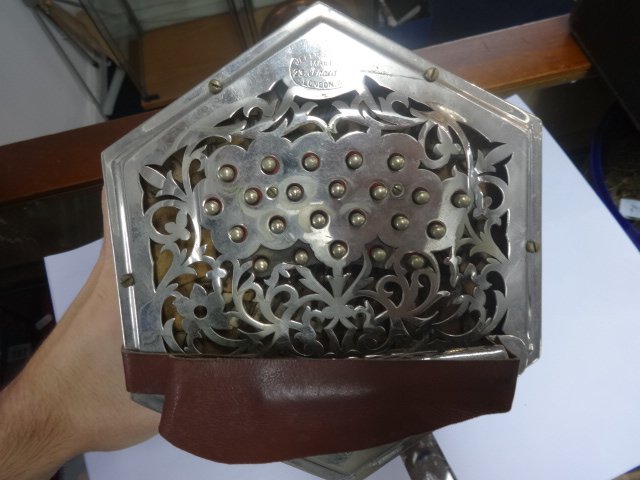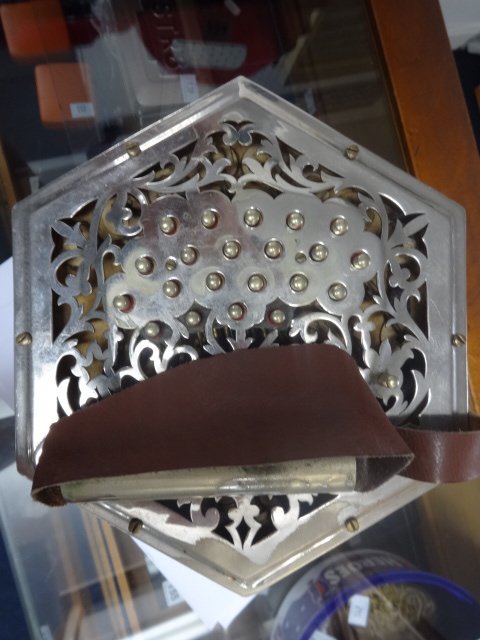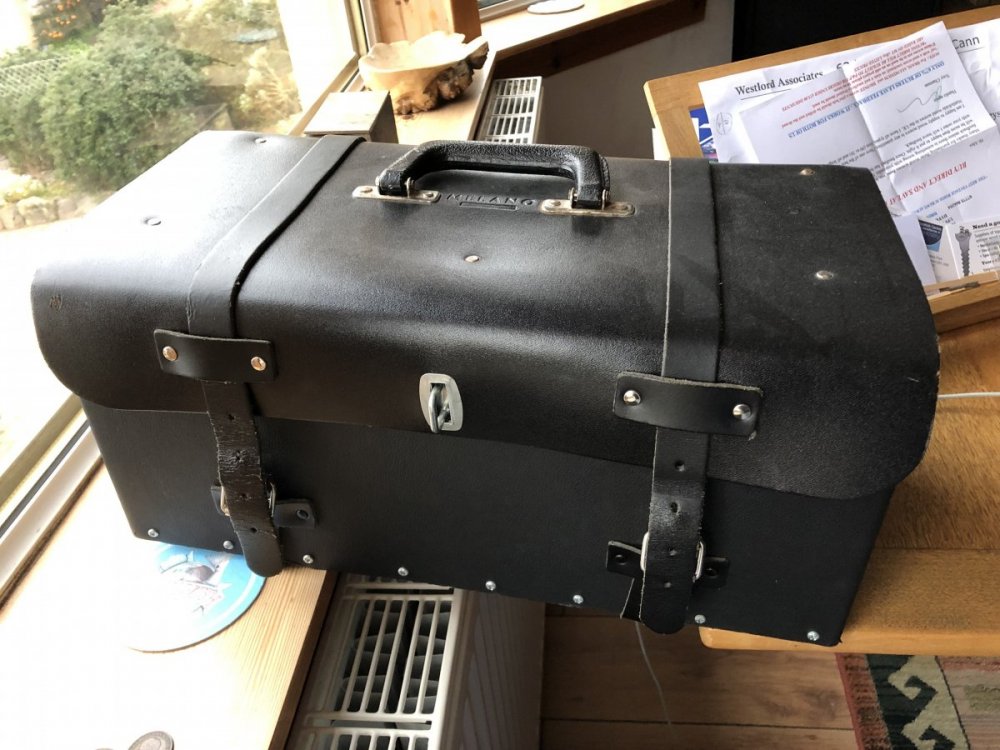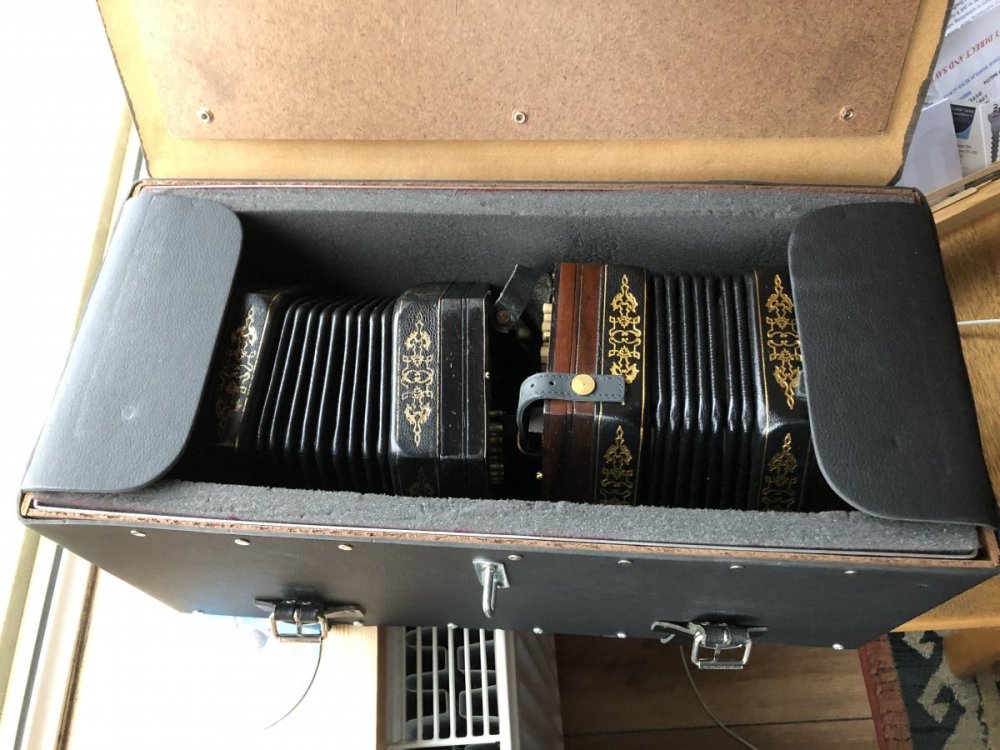
Alex West
Members-
Posts
554 -
Joined
-
Last visited
Everything posted by Alex West
-
Did anyone else see this Jeffries Bros concertina at auction this morning at the Plymouth Auction Rooms? It's a curious beast which looks like a "standard" 39 key Jeffries but with extra rows of buttons slotted into the fretwork on the left and right to make a 46 key instrument (Air button's missing though) It went for a hammer price of £2,000 which means a total cost of £2,480 before restoration - not a bad price! (Not me though - I saw it too late to register) Alex West
-
I can't imagine how painful a 3mm diameter button would be! Over the range of concertinas I've measured, the smallest diameter buttons have been 4.1mm (a number of Jeffries) and the largest diameter 7mm on a Jones. The most comfortable size for me is 5mm but the comfort does depend on the flatness and radius of the ends Alex West
-
I have the key map for a different F/C Shantyman concertina which confirms that the two left hand buttons are an F drone and Eb/C# and I'd expect the ButtonBox one to be similar. The air button on an anglo is under the right thumb (any exceptions?) I've a 50 key Ab/Eb Jeffries Anglo (50 plus air) but in a 6 3/8" body - it's a tight squeeze! Too difficult for me to post many pictures here but I can send a dropbox link if you're interested, Alex. I've just finished restoring a large Lachenal 62 key duet withou an air button - it seems odd at first but I think the duet player I've loaned it to for an extended test won't find that a big issue Alex West
-
Charlie If you look for the Red Star Brigade on Youtube, you'll find videos of a session I used to go to just outside Aberdeeen. The videos concentrate on a couple of the accordion players, Jim Halcrow from Shetland and Charlie Lawie but I'm there to the left of the screen, playing anglo. I played a GD anglo for most of these sessions but there were a limited number of tunes which fitted better (for me) on a CG Alex
-
I meant to add - in terms of the "correct key", I wonder if there is one? If the tune was composed for and played on the Highland pipes, then it would probably be in something close to Eb or Bb. (See this article for some explanation http://www.leodpypz.com/skmqa019.htm). If it was for the small pipes, then, depending on the chanter, the tune might be played in one of the sharp keys. If it's been written or adapted by a modern fiddler, then A or D is common If you're playing by yourself for your own amusement, you can play in whatever key you like and can adopt whichever technique suits you. The same applies if you're introducing the tune to a session and nobody already plays it. In a more established session, there are two opinions in typical Scottish sessions; 1. The tune was written in this key, contains these notes, grace notes and variations and can be played no other way. If you don't know the tune and can't play it exactly as written, then leave your instrument in its box and don't join in until you've learnt it properly. 2. The correct key for the tune is whichever key the starter of the tune plays it in. Whichever way the lead player takes the tune is the "right" way. Everyone who wants to join in should play in that key and adapt their plaing to suit the "lead" player (or play a non-clashing accompaniment - a "second box" approach). I've played in and enjoyed both types of session but it's important to know which company you're in to preserve dignity! My own view as an "ear" player is that everyone learns the tunes in a different way and from different sources so regional and personal variations are possible so I prefer the second approach I hope that helps; the Anglo concertina and the pipes go very well together so there's no reason that tunes written for one shouldn't be played on the other - go ahead and enjoy playing Alex West
-
There may be a few more players of Scottish music on the English than on the Anglo but it's by no means impossible, nor should it send your brain into contortions. I play a G/D anglo in the "along the rows" (and crossing when I have to) style. On a C/G, you might need to adopt the Irish technique of Anglo playing to get the fluency in the tunes. 2/4 marches, 3/4 marches, 6/8 marches - all are possible Alex West
-
Even more ridiculous price since they're missing one of the reed holding plates and yet are described as in "very good condition"! Alex West
-
You can also get felt from Steve Dickinson - maybe slightly pricey per sq m but at least he sells it in small quantities suitable for a single concertina rather than a minimum order from a larger supplier and he knows eactly what's required in terms of thickness and composition Alex West
-
David This doesn't look like a genuine Jeffries to me. The sans serif, the button layout, the bellows papers and some of the fretwork details all look non-standard Jeffries (and I've said as much to the auctioneer) Out of curiosity, what key is it in? Alex West
-
I was out of reach of an internet connection but knowing you were interested Steve, I probably wouldn't have bid anyway - but did you get it? It seemed to sell for rather more than I thought it would given the unknown provenance, date and internal condition Alex West
-
Case for carrying 2 concertinas
Alex West replied to billyboy's topic in General Concertina Discussion
Here's my solution. The case is made by an Italian company called Melano which used to have a Dutch distributor (I think). I've searched online but not found them still trading unfortunately. I got it as a toolbox in a Norwegian yacht chandlers (sadly now closed) and with suitable foam padding, it holds two concertinas very nicely with space for a paperback and other small incidentals. It's not light but it is robust (plywood covered with leather) and it's travelled with me on many flights in the overhead locker. Alex West -
William Summerscales - Concertina and Accordion Repairer
Alex West replied to Alex West's topic in Concertina History
You've seen brass reeds replaced by steel reeds before Wolf? Or do you have some experience of Mr Summerscale's work? Seems odd to do this to a 20 key instrument. Alex West -
I was recently "gifted" a 20 button rosewood ended Lachenal (No 38381) which is probably beyond repair. The interesting thing is that on both ends of the bellows are inscriptions from Wm Summerscales of Stuton via Leeds. On one side, in glorious copperplate - it says that he "tuned and repaired with steel reeds, Dec 22nd 1886. On the other it declares in pencil "Wm Summerscales, Sleeton tuner and repairer of Concertinas and Accordions" The instrument itself doesn't have the traditional Lachenal "Steel Reeds" stamps on the handrest so I wonder iwhy he said that he repaired with steel reeds, if the instrument came fitted with brass reeds and he really replaced brass reeds with steel reeds? Also the lever hoops are bent wire rather than the pierced brass which I'd expect from a fancy ended Lachenal I haven't had a really good look yet to see if the reeds look non-standard Lachenal. The reeds have light rust but the fretwrk is badly damaged and the action woodwork has woodworm so it's probably not a fixer-upper Anyone else come across Mr Summerscales? Alex West
-
Before you get to the Button Box, there are quite a number of players either in or not far away from Toronto. I know Ontario's not a small place and journey times can be - significant - but it might work! Best of luck! Alex West
-
OK Folks - is there any real use for a 39 key Lachenal McCann Duet? I've just been "Gifted" a metal ended one and it's in pretty bad shape. Most of the buttons are there but there's mould everywhere, the wood is falling apart, a lot of the reeds are rusty and I seriously question whether it's worth the effort of trying to put it back together. Normally, I'd bend over backwards to get it playable again but even if I cost my time at nothing, I wonder if it's any practical use? Is a 39 key Lachenal a good starter duet? It's just possible that I could turn it into a decent anglo but even that would mean making new ends, new bellows, some new reeds and levers. Any thoughts before I stoke the fire up and use the reeds as spares? By the way, it's number 1147 - 1900 or so? Alex West
-
WHereabouts are you? It's more than possible that you're near enough to someone who has an instrument (of whatever flavour) you might be able to try before you make a decision Alex West
-
I'm in the final stages of restoring a 62 key Lachenal New Model Duet no 755 - maybe from around 1890? What's puzzling me at the moment is that this instrument doesn't seem to be laid out the same way as other 62 key Maccanns in that it has only 25 keys on the Left (not 28) but has 37 keys on the Right, and instead of having a range from A2 to A7, it goes from C3 all the way up to C7. Lachenal catalogues of around the time seem to denote a 62 key instrument as a Baritone from Cello G or A upwards so this one seems to be somewhat higher (more like a tenor treble range?) and maybe a special of some kind. It seems to have the same range as a "standard" 56 key Maccann but with more overlap between the Left and Right hand. I'm not a Duet player so don't know if this would be normal - has anyone else come across this configuration and range before? Alex West
-
Broken End Bolt Jeffries Anglo
Alex West replied to vision2020's topic in Instrument Construction & Repair
Short answer is yes Alex West -
The demise of the English concertina.
Alex West replied to polavoy's topic in General Concertina Discussion
I'd say Scotland is one of the places where the English system is doing fine. Maybe older players still out-number the younger players but without doing a detailed head-count, there seem to be more English than Anglo instruments around. Having said that, there is rarely more than 1 concertina player at any given session Alex West -
With regard to playing a concertina close to the sea, here's where my experience differs. My main squeeze is a Jeffries G/D which I got nearly 10 years ago. I live quite close to the Firth of Clyde (within 500 metres) and we occasionally get salt storms which are bad enough to take the tender shoots off plants and turn the leaves of the trees brown. We sail during the summer and I always take a concertina on the boat with me for up to 3 months at a time. It's usually the Jeffries although one year it stayed home while I tried a less valuable instrument - but the joy of playing disappeared so I haven't tried that again. I don't play in the rain or when the waves are crashing over the sides but I do play outdoors. On reviewing the correspondence here, I thought I ought to take a look inside at least to check the reeds - not a sign of rust or tarnishing. Maybe I've been lucky but I don't think it always has to be the case that playing concertinas close to the sea necessarily involves replacing the reeds frequently Alex West
-
Concertina repair: pad/valve that won't close
Alex West replied to Steven K.'s topic in Instrument Construction & Repair
I'd echo Frank's caution - before leaping to conclusions about the cure, have a good look around to see what's causing the problem. If it's the pad failing to close it's unlikely to be something stuck in the reed (so bashing the concertina, however gently isn't the cure - and in any case, there are gentler ways to remove dust from reeds). The logical answer is that there's something preventing it closing - which could be: something physically in the way a misalignent of the lever mechanism (which might be the staple rising) friction in the action mechanism either at the lever pivot, at the button where it passes through the fretwork (unlikely with a Lachenal 20 buttin but possible) a weak or poorly performing spring There may be other issues associated with the above but the cure will depend on the problem. If it's a weak spring, then removing and regluing the pad isn't necessarily going to fix it. If it is the humidity, waiting until spring probably isn't an option! Alex West -
Mike The cross row fingering is indeed different. It was made for a specific person playing Southern English music in an idiosyncratic style but he was an anglo player first (although he did gravitate towards Cajun button accordeons before giving up free reed instruments entirely and becoming a proper musician - saxophone and drums!). Since I now play normally configured anglos, it's harder for me to get the most out of the Dipper but I still get it out occasionally for a bit of exercise Alex West
-
Looks more like sellotape holding the ends together! BTW, I have a relatively early Dipper (No 104) with pierced ends. It's a GD but with the G row an octave higher than a normal GD. It's a very piercing sound but how much of that is due to the pierced ends and how much the pitching is difficult to tell Alex West
-
Old concertina buying advice
Alex West replied to PiranhaFish's topic in Instrument Construction & Repair
As with most things, it depends. If it's the Lachenals you're looking at, the quality range when new varied from cheap mass produced beginner instruments to top end boxes with more bespoke reeds and woodwork. The ones you see on ebay are across this spectrum and it's not always easy to see what the extent of the damage and likely repairs might be. All of the issues you describe are fixable, but whether it's worth it depends on whether you can tackle the work yourself (and don't cost your time) or have to outsource it and how much extra you'd have to pay for an instrument with all of those issues fixed - up to the point of a fully restored instrument from one of the restorer/dealers. It might be worthwhile repairing Whereabouts in Scotland are you? Happy to chat more over a cup of tea if you're nearby Alex West





